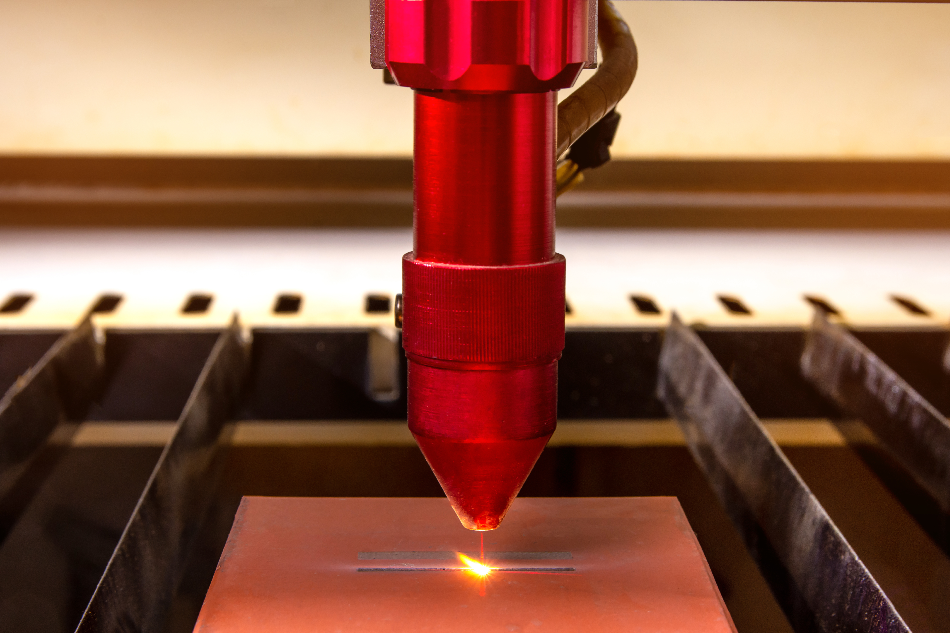
Image Credit: Fotangel/Shutterstock.com
Many different components within lasers enable them to function effectively, and many of these parts can be made from a choice of materials. One key component is the active laser medium, otherwise known as gain medium (or gain media for plural), which amplifies a laser beam so that its power becomes high enough to perform its intended task. Here, the methods for using ceramic materials as active laser materials will be discussed.
The gain media are the cause of optical gain in all lasers. ‘Gain’ within a laser is a fundamental amplification process that causes the media to transfer some of its energy to the laser beam (i.e., electromagnetic radiation beam), which increases the optical power of the laser. Without this energy transfer process, lasers would not have anywhere near the power they do now.
A material needs to exhibit quantum properties that enable it to undergo stimulated emission to facilitate the energy transfer process. The stimulated emission process arises because the gain media is excited by a pump source. This causes the active material to be excited to a higher (and metastable) energy state, and this causes either molecular or electronic transitions to occur when the active material returns to a low energy state (i.e., its ground state). During this transition, energy is released from the material; it is this energy that is transferred to the laser beam, and that increases the beam’s power.
There are many different types of materials that can be used as the active material. However, to work efficiently, the material used needs to undergo quick molecular/electronic transitions, and the separation of the energy sub-levels needs to be below the operating temperature of the laser.
In terms of other beneficial properties, materials are favored if they have high transparency, chemical stability, quantum efficiency, and optical damage threshold, as well the ability to amplify high energy pulses and generate ultra-short pulses.
The materials that also work better are those that have more active centers, which means that more transitions, and in turn, more energy can be produced. One area of gain media that varies is the ability to work over a range of frequencies. However, the gain media which work across a wide range are more favorable as it means that the laser can be tuned more easily (wide-frequency gain media make tunable lasers possible).
In short, ‘ceramic gain media’ are an active laser media that are made from ceramic materials.
Ceramic Materials in Gain Media
There are several different gain media material classes, including various gases, glasses, liquid dyes, single crystals, semiconductors, and transparent polycrystalline ceramics. In the ceramics class, there is a number that has been developed over the years. It should be noted that many of the materials can exist in both doped and undoped forms, with those doped with rare earth elements being the most efficient gain media.
Sesquioxide ceramics (such as those based around yttria and Scandia) and yttrium aluminum garnet (YAG) materials are the two most efficient ceramic gain media materials, and various doped YAG materials are used in lasers nowadays. This is because YAG materials can undergo a much higher degree of doping (which makes their properties a lot more tunable) without experiencing any quenching effects that could degrade the laser efficiency.
Sesquioxide ceramics show the most promise out of all the materials but are currently hindered by complex fabrication processes compared to YAG ceramics. Other common ceramic gain media materials include metal oxide, non-metal oxide, and composite ceramics, and while they were some of the first ceramic gain materials, their properties are not as desirable as sesquioxide or YAG materials and so are currently less used.
While many believe polycrystalline materials would not be as effective as single crystals, advances in processing methods have enabled the production of completely transparent ceramics, which have negligible grain boundary effects and very low optical scattering losses (similar to single crystal losses), while being significantly tougher than other gain materials.
Overall, ceramic materials possess some distinct benefits over single-crystal materials, such as a cheaper fabrication process, the ability to be made in more complex geometries, being more tunable due to the ability to dope the material, and being well-suited for use in composite gain media materials.
The versatility of these materials is also apparent as their thermal conductivity properties mean that they can also be used as heat sinks in high powered lasers. It is believed that ceramics will overtake other gain materials in many lasers, especially the more efficient ceramic materials.
References and Further Reading
AzoOptics: https://www.azooptics.com/Article.aspx?ArticleID=738
RP Photonics: https://www.rp-photonics.com/ceramic_gain_media.html
Disclaimer: The views expressed here are those of the author expressed in their private capacity and do not necessarily represent the views of AZoM.com Limited T/A AZoNetwork the owner and operator of this website. This disclaimer forms part of the Terms and conditions of use of this website.